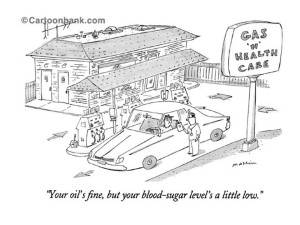 In the past few weeks, several events bolster the reality that health and health care are in Blurred Lines mode. Not Robin Thicke Blurred Lines, mind you, but the Venn Diagram overlapping kind.
In the past few weeks, several events bolster the reality that health and health care are in Blurred Lines mode. Not Robin Thicke Blurred Lines, mind you, but the Venn Diagram overlapping kind.
- Walmart launched real primary care clinics in South Carolina and Texas. These will provide services beyond urgent care, charging $4 a visit for company employees and $40 a visit for other people
- The U.S. Department of Agriculture issued a report promoting “nudges” to grocery shoppers enrolled in the Supplemental Nutrition Access Program (SNAP) to buy healthy foods
- Apple is talking with Cleveland Clinic, Johnson Hopkins, and Mount Sinai Medical Center about using HealthKit, the company’s mobile health app that will launch in the fall and track consumers’ personal health information such as calories burned, exercise, heart rate, and sleep
- Higi, in over 4,000 Rite Aid stores in 2014, combined with Stayhealthy to form the nation’s largest connected health kiosk provider with 6,000 kiosks and a “contractually scheduled” installed base of nearly 10,000 by 2015. These kiosks perform basic health screening for weight, BMI, blood pressure and heart rate, and connect to some of the most popular fitness trackers
- A ShopRite market in north Philadelphia launched a mental health kiosk to help people screen for anxiety and depression at the grocery store. The grocer is also the location of an urgent care clinic, providing access to basic health needs for the local community. The program is co-sponsored by the City of Philadelphia’s Department of Behavioral Health
- Another supermarket, Stop & Shop, in greater Hartford, Connecticut, opened two FastCare retail clinics in joint venture with St. Francis Hospital and Medical Center
- Practice Fusion bought Ring-A-Doc, a virtual physician visit company which provides entre for the health IT company in telehealth services
- WellPoint is changing its name to Anthem so more consumers recognize the health plan brand
- And, UnitedHealthcare launched a mobile health app to help consumers research health services and costs. The video explains this consumer-facing transparency tool.
- Health Populi’s Hot Points: So is the U.S. health ecosystem evolving into a real ecosystem? Will Blurred Lines come together in a tightly-woven system and solve the patchwork-quilt problems and gaps in American healthcare delivery? Health consumers – patients, caregivers, and healthy people alike — are doing more outside of the health care system than ever to bolster health. People are more often buying foods they perceive have health benefits, get immunizations at pharmacies and grocery stores, take kids for school exams, and ask grocery nutritionists about how to build a diabetes-friendly shopping cart. Shuffle the current news items listed here together and you get a blurring of health and health care, the continuum of wellness to illness and chronic care management, and increasingly, the introduction of behavioral and mental health screening outside of the primary care doctor’s office. Health is where we live, work, play, pray and learn.





 Grateful to Gregg Malkary for inviting me to join his podcast
Grateful to Gregg Malkary for inviting me to join his podcast  This conversation with Lynn Hanessian, chief strategist at Edelman, rings truer in today's context than on the day we recorded it. We're
This conversation with Lynn Hanessian, chief strategist at Edelman, rings truer in today's context than on the day we recorded it. We're